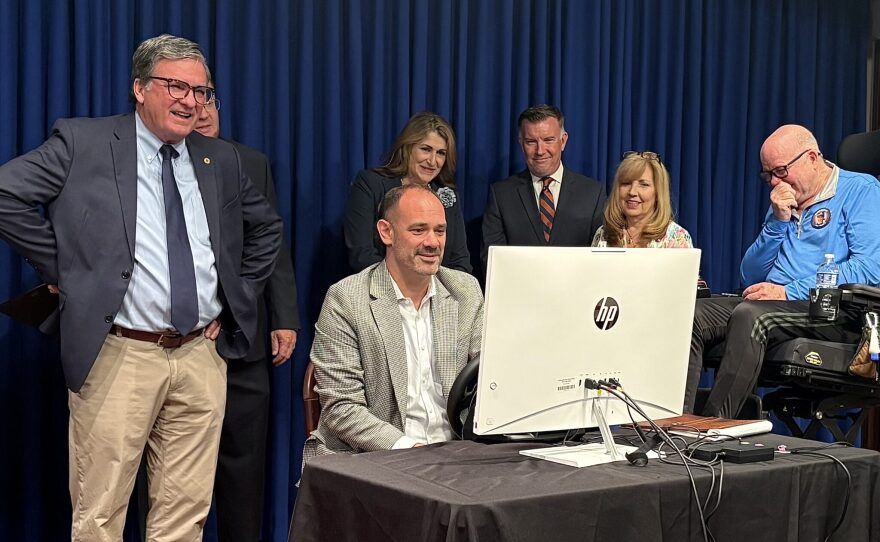State officials experienced first-hand the perils of distracted driving, before a state law banning the use of handheld cell phones and other electronic devices takes effect next week. PennDOT hosted a distracted driving simulation Tuesday in the State Capitol in Harrisburg to raise awareness about the dangers it can pose to motorists.
The legislation takes effect on June 5. Gov. Shapiro signed it into law last year. Named after 21-year-old Paul Miller Jr., a college senior who was killed by a distracted driver in 2010, the law bans any use of a handheld cell phone, tablet or other electronic device while driving, including while stopped at a red light.
Miller’s parents Eileen and Paul Miller, representatives from PennDOT, the Pennsylvania State Police, the Pennsylvania Turnpike Commission, the state Insurance Department, and the law’s prime sponsor, state Sen. Rosemary Brown (R-Monroe), watched as Insurance Commissioner Michael Humphreys attempted to drive in a simulator while typing a text message. It ended with a crash and simulated court date.
PennDOT uses the simulator at events across the state to highlight the dangers of distracted and impaired driving.
“At almost every school we go to, we have young people stand up from this and go, ‘I am never going to drive distracted, because I see now just how quickly things can go wrong,’” PennDOT spokesperson Steve Harmick said. “So our hope is, in the future, we’ll see things like distracted driving incidents go down.”
PennDOT Secretary Mike Carroll emphasized the law will “save lives across our Commonwealth,” adding, “It’s time for drivers to put the phone down and focus on driving and text while they are not driving.”
The enactment of Paul Miller’s law is the culmination of over a decade of advocacy by Eileen and Paul Miller. Brown first introduced a bill on distracted driving over 12 years ago after Eileen, a constituent, contacted her to request help advocating for distracted driving legislation.
“Pennsylvania has a very serious problem with distracted driving, particularly drivers using cell phones and electronic devices behind the wheel,” Brown said. “These distractions aren’t occasional or brief. They’re consistent. They’re repetitive and they’re dangerously long lasting, which makes them the highest focus.”
PennDOT reported 9,950 crashes caused by distracted driving last year, which resulted in more than 6,000 injuries and 49 deaths.
“Every day, our troopers respond to crashes that could have been prevented. Crashes that happened simply because someone wasn’t paying attention to the road,” state police Maj. Robert Krol, director of the Bureau of Patrols, said. He emphasized troopers will be enforcing the law.
“Police will be actively looking for this behavior and can stop a driver solely for this violation alone,” he said. “No other reason is needed.”
For the first year, police will only issue warnings to drivers caught violating the law. Starting in June 2026, violators will be hit with a $50 fine. Motorists will still be permitted to contact emergency services while driving and continue to use hands-free technology to make calls and send texts.
Critics of the legislation, including the American Civil Liberties Union of Pennsylvania, have argued the law will “expand police power to engage in pretextual traffic stops for a crime that will be difficult to prove.”
The Black Legislative Caucus, as well as Shapiro, have argued that collecting this data will increase transparency and prevent racial bias in the enforcement of traffic laws.
The collected data will not be publicly available. The law specifically states the data will be exempt from access through Pennsylvania’s Right-to-Know law. Instead, the state police or a designated third-party will compile and annually release a report based on the data.
State police have previously released similar third-party reports on their traffic stops in the past.
“As one of the first police agencies to voluntarily collect traffic-stop information, [Pennsylvania State Police] has one of the most comprehensive and high-quality data collection efforts on traffic stops in the country,” according to Myles Snyder, state police communications director. “Our Contact Data Reporting program is designed to analyze demographic and other information from traffic stops to examine whether any racial or ethnic disparities exist, build trust with the public and identify opportunities for improvement in policy and training.”
Vincent DeFonzo is an intern with the Pennsylvania Legislative Correspondents’ Association.


